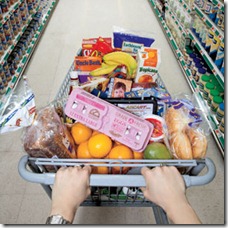 Visiting my parents in New Hampshire this week, I spent a lot of time in the grocery store. As a matter of fact, we shopped for groceries every single day.
Visiting my parents in New Hampshire this week, I spent a lot of time in the grocery store. As a matter of fact, we shopped for groceries every single day.
According to industry experts, seniors are the most frequent shoppers, averaging more shopping trips annually than any other cohort. Why? Possibly because seniors are less able to carry heavy bags and are more likely to be financially strapped, so shopping on an as-needed basis works for them.
Over the next 10 years, U.S. households are predicted to grow 8 percent, according to market research firm A.C. Nielsen, but households closer to the poverty level are expected to grow twice as fast, at 17 percent.
The majority of this growth is attributed to seniors living on limited budgets.
Cash-strapped seniors have honed their shopping habits in recent years as the economy has worsened. More seniors rely on a shopping list, even though research shows they spend more time in the store and travel down every aisle more often than other generations. Shopping lists can help seniors limit the number of impulse purchases they make.
Seniors more often compare unit prices and use store circulars to identify sales. They also redeem more coupons, although they use the Internet less, limiting their options.
Seniors are giving up some of their favorite brands in order to save money. In particular, seniors are purchasing store brand personal care and healthcare products at a much higher rate than younger generations.
My sister noted that the senior couple in front of her at the grocery store last week bought two bags of groceries for $18. My sister’s two bags of groceries totaled more than $50.
What was the difference? The senior couple purchased more basic ingredients and in- season produce, a trend that is being seen nationally.
Seniors on a budget are turning to other outlets besides grocery stores for bargains, including drug stores, dollar stores and convenience stores.
Besides providing good values, these markets are smaller and easier to navigate. Frequently the shops are on the bus route or in walking distance of a senior’s home, making them more convenient, in addition to being affordable.
Despite budget constraints, seniors are spending more money than other generations in certain categories.
On average the largest spending category for seniors is pet food, at $198 per year.
The next largest spending categories for seniors are wine, at $124 per year, and vitamins, at $107 per year. As a pet-owning wine lover, I applaud seniors’ priorities.
One fact that may seem out of place is that seniors, more than any other generation, see shopping as a chore, yet they spend more time walking up and down each aisle, thus extending their time in the store. Because of certain challenges, such as transportation, budgets, heavy groceries and the confusing array of choices, it isn’t surprising that seniors might see shopping as a chore.
Or perhaps the challenge lies in meeting their dietary restrictions. Low-salt, low-fat, low-sugar, high-fiber and low-calorie options take time and energy to find in stores that are filled with so many not-so-good-for-you choices.
There are important messages here for retailers who want to meet the needs of the upcoming age wave. Stock smaller sizes of brand-name items so seniors on a budget can buy their favorite brands.
Offer print coupons versus those just on the Internet. Clearly identify healthful options in the store. Place items seniors frequently purchase close to the front register and continue to offer carryout service.
More ...
Tags: seniors shopping habits,A,C. Niesen